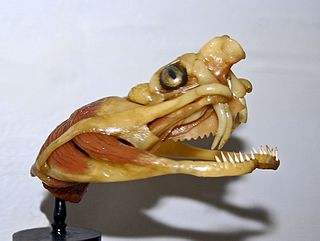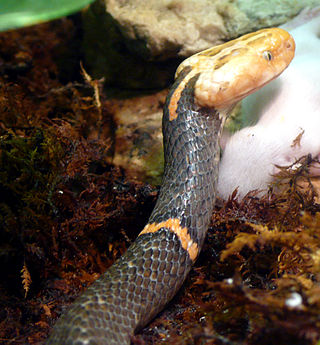Related Research Articles

Venom or zootoxin is a type of toxin produced by an animal that is actively delivered through a wound by means of a bite, sting, or similar action. The toxin is delivered through a specially evolved venom apparatus, such as fangs or a stinger, in a process called envenomation. Venom is often distinguished from poison, which is a toxin that is passively delivered by being ingested, inhaled, or absorbed through the skin, and toxungen, which is actively transferred to the external surface of another animal via a physical delivery mechanism.

Francesco Redi was an Italian physician, naturalist, biologist, and poet. He is referred to as the "founder of experimental biology", and as the "father of modern parasitology". He was the first person to challenge the theory of spontaneous generation by demonstrating that maggots come from eggs of flies.

Cerastes cerastes, commonly known as the Saharan horned viper or the desert horned viper, is a venomous species of viper native to the deserts of Northern Africa and parts of the Arabian Peninsula and Levant. It is often easily recognized by the presence of a pair of supraocular "horns", although hornless individuals do occur. Three subspecies have been described.

Snake venom is a highly toxic saliva containing zootoxins that facilitates in the immobilization and digestion of prey. This also provides defense against threats. Snake venom is injected by unique fangs during a bite, whereas some species are also able to spit venom.

Russell's viper is a venomous snake in the family Viperidae native to the Indian subcontinent and one of the big four snakes in India. It was described in 1797 by George Shaw and Frederick Polydore Nodder, and named after Patrick Russell, who wrote about it in his 1796 work An account of Indian serpents, collected on the coast of Coromandel.

Sankar Kumar Pal is a computer scientist and president of the Indian Statistical Institute, Kolkata. He is a computer scientist with an international reputation on pattern recognition, image processing, fuzzy neural network, soft computing, granular mining, and machine intelligence. He founded the Machine Intelligence Unit in 1993, and the Center for Soft Computing Research: A National Facility in 2004, both at the ISI. He is the founder president of the Indian National Academy of Engineering, Kolkata Chapter.

The monocled cobra, also called monocellate cobra and Indian spitting cobra, is a venomous cobra species widespread across South and Southeast Asia and listed as Least Concern on the IUCN Red List.

Atheris squamigera is a venomous viper species endemic to west and central Africa. No subspecies are currently recognized.

Atheris is a genus of vipers known as bush vipers. They are found only in tropical subsaharan Africa and many species have isolated and fragmented distributions due to their confinement to rain forests. Like all other vipers, they are venomous. In an example of convergent evolution, they show many similarities to the arboreal pit vipers of Asia and South America. Seventeen species are currently recognized.

Azemiopinae is a monogeneric subfamily created for the genus Azemiops that contains the viper species A. feae and A. kharini. They are commonly known as Fea's vipers. No subspecies are recognized. The first specimen was collected by Italian explorer Leonardo Fea, and was described as a new genus and new species by Boulenger in 1888. Formerly considered to be one of the most primitive vipers, molecular studies have shown that it is the sister taxon to the pit vipers, Crotalinae. It is found in the mountains of Southeast Asia, in China, southeastern Tibet, and Vietnam. Like all other vipers, they are venomous.

Montivipera xanthina, known as the rock viper, coastal viper, Ottoman viper, and by other common names, is a viper species found in northeastern Greece and Turkey, as well as certain islands in the Aegean Sea. Like all other vipers, it is venomous. No subspecies are currently recognized.
Chen-Yuan Lee, was a Taiwanese pharmacologist and political activist. He is famous for his research on snake venom. He was a recipient of the prestigious Redi Award from the International Society on Toxinology (IST), and was also a former president of the society. He was a former dean of the National Taiwan University College of Medicine. After his retirement from researching, he focused on participating in the Taiwan independence movement and many democratic movement. Lee had founded many political organizations such as the "100 Action Union" (100行動聯盟), Foundation of Medical Professionals Alliance in Taiwan. He was also the first chairperson of the Taiwan Independence Party.

Moyse Charas, or Moses Charas, was an apothecary in France during the reign of Louis XIV. He became famous for publishing compendiums of medication formulas, which played vital roles in the development of modern pharmacy and chemistry. He is best remembered for his medical compendium Pharmacopée royale galénique et chymyque published in 1676
International Society on Toxinology (IST) is a global society of scientists and clinicians working for the advancement of venoms, poisons and toxins. It was founded in 1962 with an aim to advance knowledge on venoms, poisons and toxins of animal, plant and microbial origin.

Steven A. Seifert (1950–2022) was an American medical toxicologist. He was a professor of emergency medicine at the University of New Mexico, as well as the medical director of the New Mexico Poison and Drug Information Center. Since 2017, he was the editor-in-chief of Clinical Toxicology. He was also a jazz tenor saxophonist.

Ashis K. Mukherjee is an Indian biochemist specializing in snake venom biochemistry, molecular biology and microbiology. He served as the Head of the Department of Molecular Biology and Biotechnology of Tezpur University during 2008– 2011. Known for his research on snake venom biochemistry, proteomic composition and other proteins related work from microbial and plant background, Mukherjee serves as the head and coordinator of the Nodal Center for Medical Colleges and Biomedical Research Institutes of North East India at Tezpur University. The Department of Biotechnology of the Government of India awarded him the National Bioscience Award for Career Development, for his contributions to biosciences, in 2013. Mukherjee has also received the Visitor's Award 2018 for research in the fields of basic and applied sciences from the President of India.
The North American Society of Toxinology (NAST) is a North America-based, international, multidisciplinary organization dedicated to the advancement of the science of all things venomous. It was founded in 2012 and is a 501(c)(3) organization under the U.S. Internal Revenue Service.
José María Gutiérrez is a Costa Rican toxinologist known for his work with animal venoms and development of antivenoms. He won the Redi Award, the highest honor conferred by the International Society on Toxinology in 2017 for his work.
References
- 1 2 Mebs D (2012). "History of the International Society on Toxinology - A personal view". Toxicon. 69: 21–8. doi:10.1016/j.toxicon.2012.11.021. PMID 23237723.
- ↑ Francesco Redi (1988). Knoefel PK (ed.). Francesco Redi on Vipers. Leiden, the Netherlands: E.J. Brill. pp. 11–17. ISBN 9004089489 . Retrieved 2013-04-18.
- 1 2 Habermehl GG (1994). "Francesco Redi—life and work". Toxicon. 32 (4): 411–417. doi:10.1016/0041-0101(94)90292-5. PMID 8052995.
- ↑ Hayes AN, Gilbert SG (2009). "Historical milestones and discoveries that shaped the toxicology sciences". EXS. 99 (1): 1–35. doi:10.1007/978-3-7643-8336-7_1. PMID 19157056.
- ↑ International Society on Toxinology. "IST Redi Awards" . Retrieved 2013-04-18.
- ↑ International Society on Toxinology. "International Society on Toxinology By-Laws Article X" (PDF). Retrieved 2013-04-18.
- ↑ "The IST Redi award – The International Society on Toxinology". www.toxinology.org. Retrieved 2023-09-22.